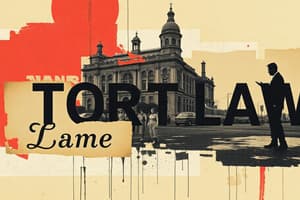Podcast
Questions and Answers
Which of the following is NOT a key element required to establish negligence?
Which of the following is NOT a key element required to establish negligence?
- The breach caused actual damage or injury
- The defendant breached that duty of care
- The defendant owed the claimant a duty of care
- The defendant had malicious intent (correct)
The concept of negligence is based on the idea of what a reasonable person would do under similar circumstances. What does the 'reasonable person' standard represent?
The concept of negligence is based on the idea of what a reasonable person would do under similar circumstances. What does the 'reasonable person' standard represent?
- The average level of care and competence expected from a professional
- The ordinary level of care and prudence expected from the general public (correct)
- The minimum legal requirements for safety and due diligence
- The highest possible level of care and precaution
If a person fails to exercise reasonable care, resulting in harm to others, what type of legal responsibility do they incur?
If a person fails to exercise reasonable care, resulting in harm to others, what type of legal responsibility do they incur?
- Contractual liability
- Criminal liability
- Strict liability
- Tort liability (correct)
Which of the following statements about negligence is FALSE?
Which of the following statements about negligence is FALSE?
What is the central component that links the key elements of negligence together?
What is the central component that links the key elements of negligence together?
Flashcards are hidden until you start studying
Study Notes
Law of Torts and Negligence
Overview of Torts
Understanding the complex area of legal responsibility known as "Law of Torts" begins with understanding what constitutes a tort. As explained in, a tort is a civil wrong independent of contract that involves an injury to someone else. Unlike a crime, where the state initiates prosecution, a civil action for tort is instigated by the injured party. The person responsible for committing the act of tort (the defendant) has a legal obligation to compensate the plaintiff for any resulting harm.
The Concept of Negligence
Negligence is a type of tort where someone fails to exercise reasonable care in their actions or omissions, thereby causing injury or damage to others. As defined in, negligence can be understood as a breach of duty that amounts to a civil wrong. A tortfeasor (one who commits a tort) is held liable to pay compensation for any harm caused due to their negligent behavior.
Key Elements of Negligence
To establish negligence, four key elements must be present. The defendant must owe the claimant a duty to take reasonable care. If that duty is breached, and damage occurs as a result, with the breach being foreseeable, then an actionable claim in negligence can arise. These elements are interrelated, with the breach being the central component that links the other factors together.
The Reasonable Person Test
The concept of negligence is based on the idea of what a reasonable person would do under similar circumstances. This "reasonable person" standard is used to assess whether or not an individual has breached their duty of care. In legal terms, a negligent act occurs when someone omits to do something which an ordinary, prudent person would have done, or does something which no ordinary, prudent person would have done.
Conclusion
In summary, tort law covers civil wrongs that result in injury to others. Negligence is a specific type of tort where one party fails to exercise reasonable care, causing harm to another. By understanding these principles, we can better navigate the complexities of Law of Torts and its application in real-world situations.
Studying That Suits You
Use AI to generate personalized quizzes and flashcards to suit your learning preferences.




